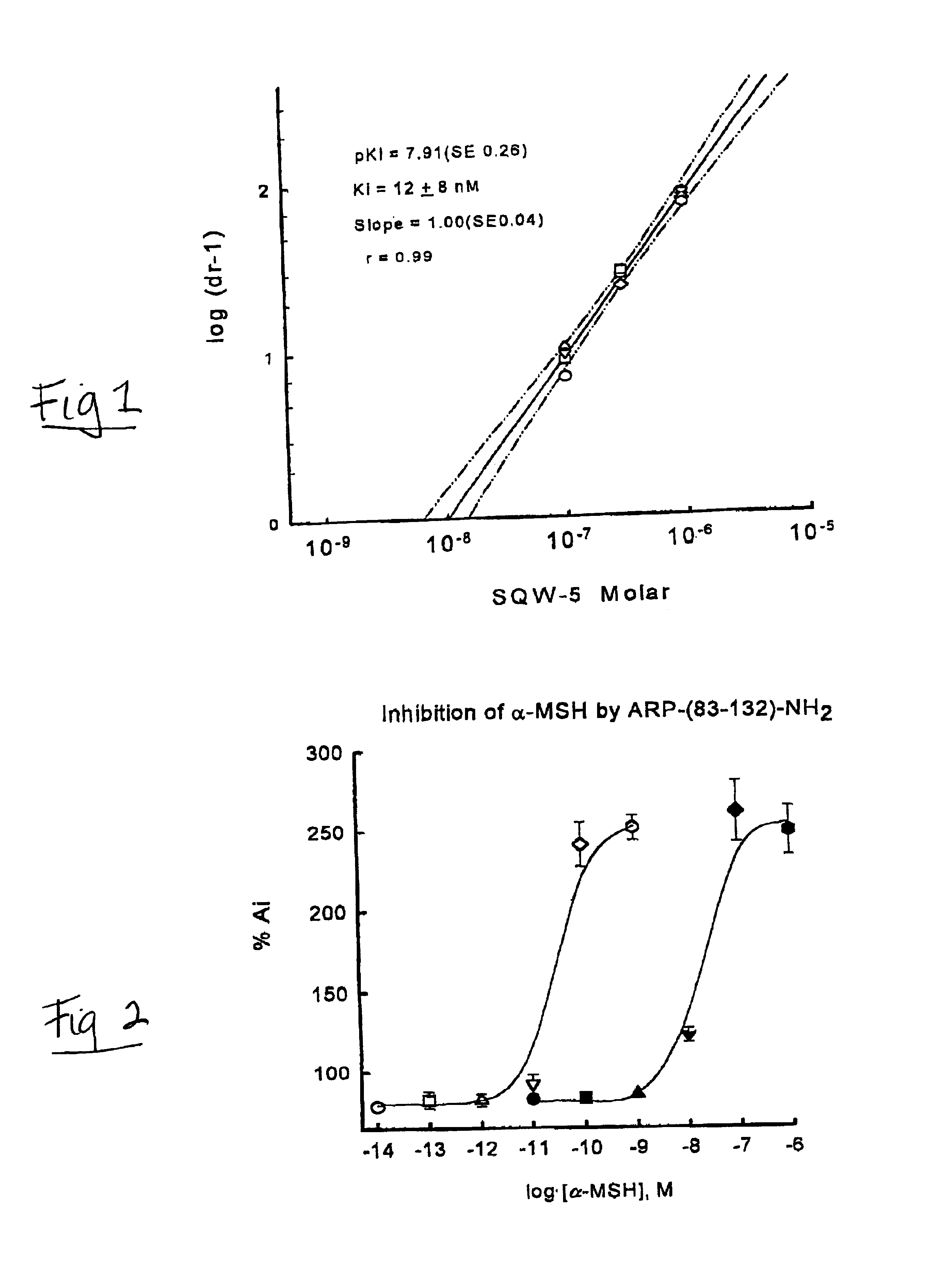Melanocortin receptor antagonists and modulations of melanocortin receptor activity
a technology of melanocortin receptor and melanocortin receptor, which is applied in the direction of peptides, peptide/protein ingredients, peptide sources, etc., can solve the problems of rarely inducing complete remission, chemotherapy has a response rate of only 20 to 25 percent, and sunscreen does not protect skin cancer. to achieve the effect of increasing the potency
- Summary
- Abstract
- Description
- Claims
- Application Information
AI Technical Summary
Benefits of technology
Problems solved by technology
Method used
Image
Examples
example 1
Dyn A(6-12) Analogs Demonstrate MCR Antagonist Activity by Blocking α-MSH Activation of Xenopus MC Receptors
[0043]Dynorphin A peptides have no direct stimulatory effect on MC receptors endogenous to Xenopus melanophores but inhibited activation of these receptors by α-MSH. To compare the relative potency of various dynorphin A(6-12) analogs, IC50 measurements were made against a fixed concentration (600 pM) of α-MSH. Melanophores were used because dynorphin peptides were of comparable potency at both frog and human MC receptors.
[0044]A graphical illustration for the determination of the antagonist potency, as measured by Ki, is shown for the analog SQW-5 (FIG. 1). The melanophores in the presence of 600 pM of α-MSH have an absorbance 200% greater than the initial value (Ai). Increasing concentrations of SQW-5 block the α-MSH effect and the increased light passing through the aggregated melanosomes is measured by the decrease in absorbance. The logistic fit of the data gives the IC50...
example 2
Melanocortin Receptor Antagonist Activities of SQW-5 and Mystixin-7 in Cells Transfected with the Human MCR-1 and MCR-4 Receptors
[0050]Human embryonic kidney (HEK-293) cells were maintained in modified Eagle's medium (DMEM / H-16 / F-12) with 10% fetal calf serum (FBS), 100 U / mL penicillin “G” and 100 μg / mL streptomycin (P / S; Gemini). Transfections were performed using cDNA containing the human MCR-1 receptor (pcDNAI / NEO.hMC1), or MCR-4 (pcCMV.hMC4) receptors. HEK-293 cells are stably transformed with the human MCR-1 and MCR-4 receptors by electroporating 20 μg of plasmid cDNA using a Gene Pulser transfection apparatus (450 V, 960 μF; BioRad, Hercules, Calif.). After six days, stable MC clonal cell lines were selected by addition of 400 μg / ml G-418 to the medium and kept frozen for future use.
Cyclic-AMP and Concentration-Response Measurements
[0051]Peptide concentration-response measurements are made in HEK-293 cells by quantifying cAMP levels using a [8-3H]-CAMP kit from Amersham. Brief...
example 3
[0056]HEK-293 cells were maintained and transfected As described in Example 2. HEK-293 cells were stably transformed with the human MCR-1, MCR-3, and MCR-4 receptors by electroporating 20 μg of plasmid cDNA (≈8×106 cells per 800 μL in 100% Ca2+ / Mg2+-free phosphate-buffered saline in 0.4 cm cuvettes at 400V, and 960 μF). After six days stable MC clonal cell lines were selected by addition of 400 μg / mL G-418 (Geneticin; Gibco / BRL) to the medium.
[0057]Concentration response measurements were made also as described in Example 2, but in Xenopus fibroblasts, COS-7, HEK-293, and Y1 cells.
[0058]Dynorphin peptides were found to inhibit α-MSH-mediated activation of three recombinant human MC receptors stably expressed in HEK cells. The opioid congener dynorphin A(1-13)-NH2 (30 μM) produced a 300- to 1500-fold shift in concentration-response curves to α-MSH at each of the MCR-1, MCR-3, and MCR-4 receptor subtypes tested. The EC50 for α-MSH alone was 1.4±0.6, 4.2±2.1, and 3.0±1.7 nM, for the MC...
PUM
| Property | Measurement | Unit |
|---|---|---|
| Molar density | aaaaa | aaaaa |
| Molar density | aaaaa | aaaaa |
| Molar density | aaaaa | aaaaa |
Abstract
Description
Claims
Application Information
 Login to View More
Login to View More - R&D
- Intellectual Property
- Life Sciences
- Materials
- Tech Scout
- Unparalleled Data Quality
- Higher Quality Content
- 60% Fewer Hallucinations
Browse by: Latest US Patents, China's latest patents, Technical Efficacy Thesaurus, Application Domain, Technology Topic, Popular Technical Reports.
© 2025 PatSnap. All rights reserved.Legal|Privacy policy|Modern Slavery Act Transparency Statement|Sitemap|About US| Contact US: help@patsnap.com


